Traditional Mexican pozole (posole) is a rich, bold and satisfying stew – and easier to make thank you think!
This Pozole Rojo is restaurant delicious (or better!), accidentally healthy, feeds a crowd (or great to freeze) and is layered with complex flavor. It’s made with juicy shredded, pork, earthy dried chiles, hominy (like giant corn kernels), fire roasted tomatoes, tangy green chiles, aromatic onions and garlic all topped with contrasting, cool, crunchy toppings of shredded cabbage, radishes, cilantro, lime, and avocados. This pozole recipe is warm and comforting, hearty, savory and practically hypnotic. It also makes fabulous leftovers (tastes even better the next day!) for a sensational make ahead meal of lunch through out the week.
Mexican Soup recipes are some of our favorite fall/winter dinners around here. If you’re looking for more easy, comforting, one pot Mexican soups, you’ll love Chicken Tortilla Soup, Crockpot Verde Chicken Tortilla Soup, Cheesy Taco Soup, Chicken Enchilada Soup, Chicken Fajita Soup, Albondigas Soup, and Caldo de Pollo.
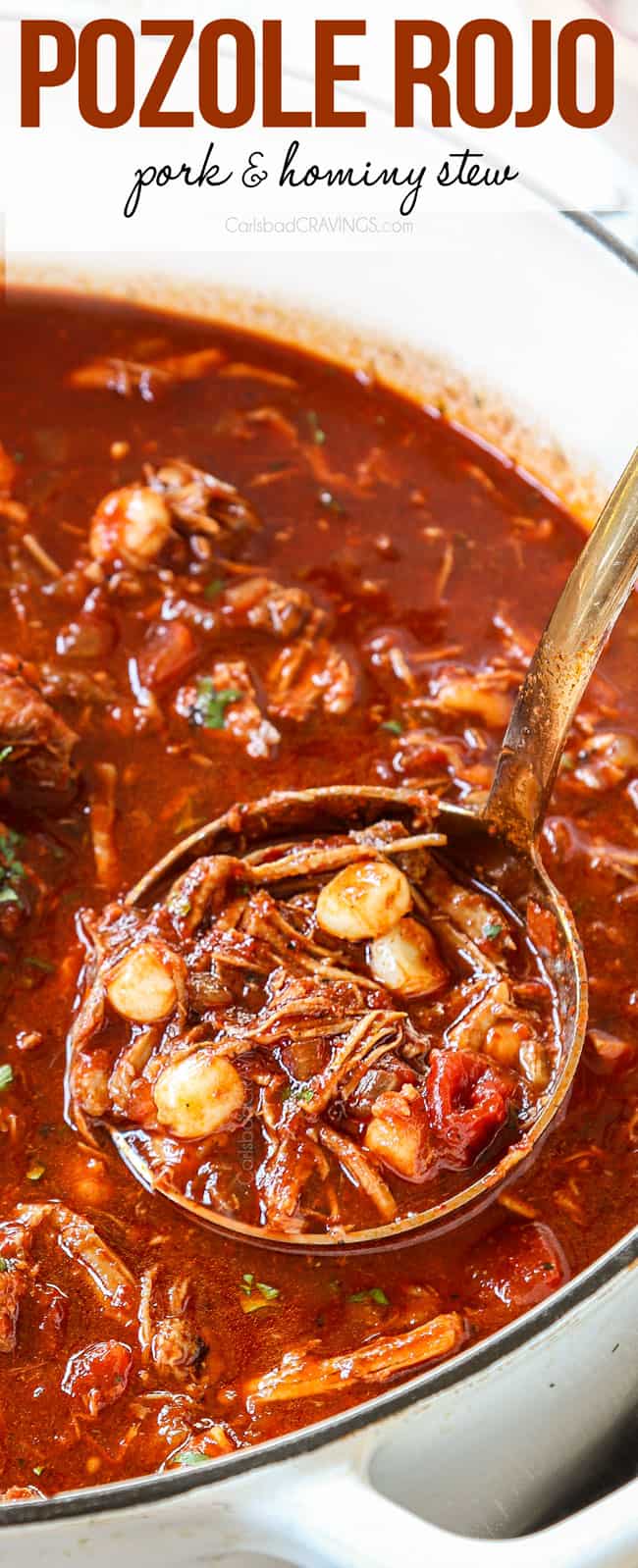
PIN THIS RECIPE TO SAVE FOR LATER
What is Pozole?
Pozole is one of Mexico’s most iconic and beloved dishes, served as an everyday meal, for large family gatherings or to celebrate festive occasions. It is often served on New Year’s Eve, Mexican Independence Day, birthdays, Christmas and other holidays.
Pozole is a cross between a brothy soup and hearty stew that is rich, satisfying, earthy and layered with flavor. Pozole is made throughout Mexico in several distinct styles: pozole blanco, pozole rojo and pozole verde. Pozole blanco boasts a clear broth, made with hominy but without chiles. Pozole verde boasts a green broth made with hominy and salsa verde from tomatillos, cilantro, and jalapenos. Pozole rojo boasts a dark crimson broth made with hominy and a red chile sauce made from ancho, guajillo and sometimes a couple arbol chiles for heat.
Pozole blanco and pozole rojo are typically made with pork and pozole verde is typically made with chicken, although this can vary from region to region, household to household, or even day to day. Vegetarian pozole does exist but is not as common.
While each version of pozole soup includes several variations, they all have one thing in common – hominy. If you aren’t familiar with hominy, it is dried field corn kernels treated with an alkali solution that removes the hull and germ of the corn and boiled until tender but still chewy. The grains puff up to about twice their normal size, giving them the appearance of giant corn kernels. This process also creates a more complex, earthy, sweet corn flavor.
In addition to hominy, pozole is also known for its toppings, especially because the soup itself is relatively simple. The toppings provide fresh, contrasting flavor and crunchy texture. Pozole toppings are a matter of availability and taste, but typically include radishes, green cabbage, onions, avocados, cilantro and lime juice.
Are pozole and posole the same?
Yes! You will see pozole spelled both pozole and posole, largely because the “s” and the “z” are pronounced the same in Mexican Spanish. The original, preferred spelling in Mexico, however, is pozole with z. Posole with an s is more often seen in American Southwest spellings.
What does pozole mean?
Pozole is pronounced [po’sole] in Spanish. It comes from the Nahuatl word, pozolli, which some claim means ‘hominy’ and others claim it means ‘frothy.’ “Frothy” would refer to the foam rising to the surface of the hominy’s boiling water-lye preparation.
Nahuatl is an Uto-Aztecan indigenous language spoken in various forms from pre-Hispanic times until the present day and is the second most commonly spoken language in Mexico after Spanish.
Where did Pozole come from?
Warning: this info could be disturbing, I was disturbed. According to research by the Instituto Nacional de Antropología e Historia (National Institute of Anthropology and History) and the Universidad Nacional Autónoma de México, pozole was originally made by the Aztec people for special occasions using human flesh and maize (corn) because they considered it a sacred plant.
They created hominy from maize through a process called nixtamalization in which the corn soaked in an alkaline solution made from slaked lime, lye, or wood ash. Instead of pork, the flesh of human prisoners was used after they were killed in a ritual sacrifice. The resulting pozole was shared among the whole community as an act of religious communion. After the Conquest in the 1500s and cannibalism was banned, pork became the protein of choice.
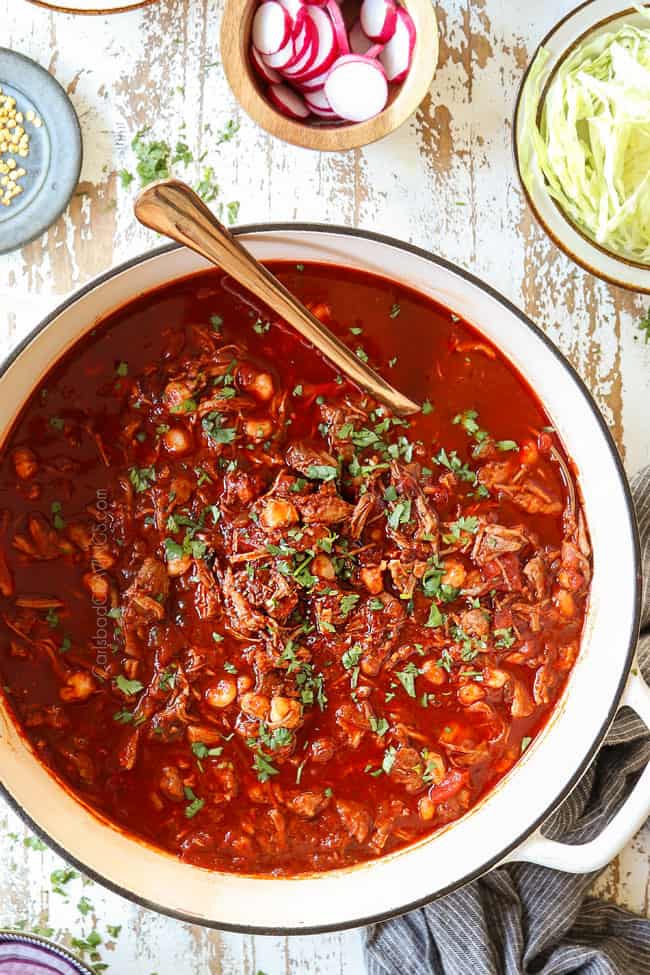
Pozole Recipe Basics
The recipe I’m sharing with you today is for pozole rojo which features red chile peppers and is fantastic. So, before I dive into the recipe, you may be wondering, is authentic Mexican pozole difficult to make? The answer is no, but it also isn’t quick to make either. Pozole is not just a dump and simmer stew, but requires a few steps but each step is very easy and most of the time is hands off cooking. The end result is well worth the effort and a stew everyone will be asking you to make again and again.
Making posole soup includes 3 main steps: searing the pork, baking the pork in broth and making the chili sauce. Here’s a quick overview:
The pork
Authentic versions of pozole rojo are made with bones from the head, neck, shank and feet of a pig, supplemented with some boneless meat from the shoulder or loin. The bones provide rich, porky flavor and give the stew body, but this process can be simplified by using a juicy bone-in pork butt. The pork butt provides tender, juicy, fall apart meat and the bone provides added flavor.
The pork roast is chopped into 4-inch chunks then seared before being popped in the oven with the broth and aromatics. The smaller pork chunks cook more evenly and more quickly than a while roast and are easier to shred than small cubes. Popping the whole soup pot in the oven also provides more even cooking and most importantly, allows you stress free-freedom without having to babysit a simmering soup.
The broth
As far as the rest of ingredients, chicken broth provided the savory depth, canned fire roasted diced tomatoes add a smokey acidity, green chilies add a subtle, lively tang, Mexican oregano adds earthy, citrusy notes and canned hominy adds a light sweetness and pleasant chewy texture. Dried hominy is authentic to pozole but canned hominy is easy to find and is commonly used as a substitute.
The chiles
For the chiles, I like to use guajillo chiles for their rich, slightly sweet flavor and 1-2 arbol chiles for their fiery heat. Of course, you don’t have to add the arbol chiles if you want an extremely mild soup. The chiles are charred in a cast iron skillet, simmered then pureed into a thick sauce which gets added to the soup after the pork emerges fall apart tender from the oven. The resulting pozole rojo is rich, earthy, aromatic and like nothing you’ve ever tasted before – in the very best possible way.
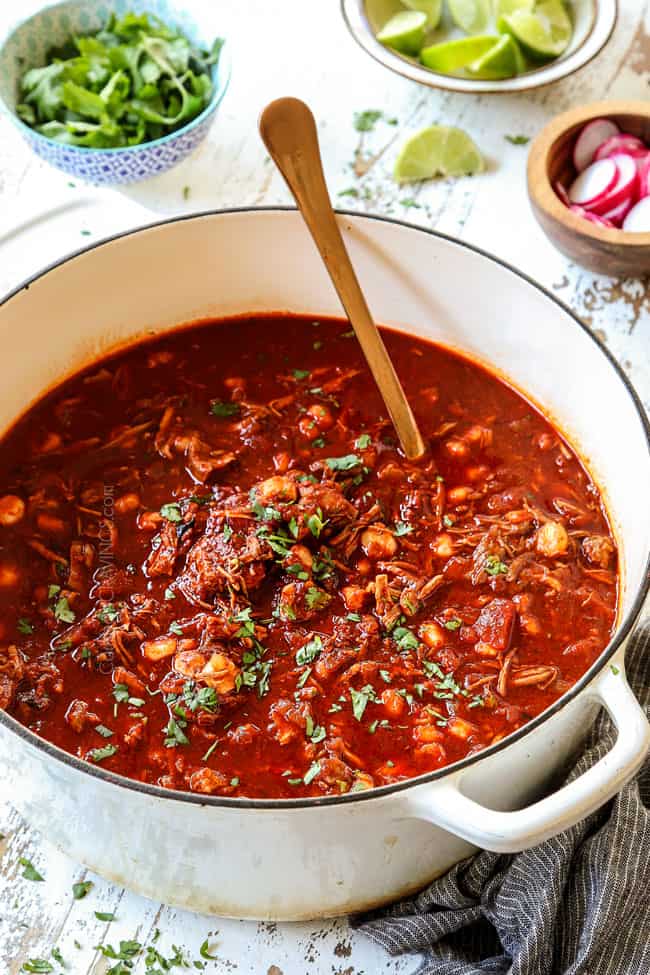
Pozole Rojo Ingredients
This pozole recipe is made with just few ingredients. Hopefully, I’ve already answered your questions about the dried chiles and hominy, so the rest of the ingredients should be pretty straight forward:
- Vegetable oil: we need an oil with a high smoking point to sear the pork.
- Pork butt/shoulder: You’ll want to use 4-5 pounds pork butt or pork shoulder. Both come from the front of the pig (not the rear). If you have a choice between pork butt and pork shoulder, use pork butt, often called Boston butt. It is named after the barrels (butts) pork used to be stored in around the time of the Revolutionary War. Pork butt has more fat marbling throughout the meat so it emerges more fall-apart-tender. Be sure to trim off any excess fat and reserve the bone to add to the pot for added flavor.
- Hominy: is what this recipe is named after and should not be skipped! Use canned hominy located near the corn at your grocery store.
- Chicken broth: use low sodium broth so we can control the salt.
- Onion: one large yellow onion to build the flavor base of the soup.
- Garlic cloves: fresh is best but you may substitute with 1 teaspoon garlic powder.
- Fire roasted tomatoes: boast a wonderful smoky flavor and are sweeter with less acidity than regular diced tomatoes. Most grocery stores carry them but if you can’t find them, then substitute regular diced tomatoes.
- Canned mild diced green chilies: make sure you purchase mild green chiles – I have accidentally used the hot chilies before and they are HOT! Mild green chiles, however are more tangy than hot so you don’t have to worry about them making your soup spicy.
- Dried peppers: 4 oz. guajillo chile peppers, or 4 oz. of a combination of guajillo and ancho peppers. You can also throw in a couple arbol peppers for a spicy soup.
- Oregano. Mexican oregano with its lemon and citrus flavors is best but you may also use traditional/Italian oregano.
- Bay leaves: their minty pepperiness awakens and refreshes the soup.
- Pork rub seasonings: ground cumin, garlic powder, onion powder, smoked paprika, kosher salt, and pepper are rubbed into the pork before it’s seared to create an incredibly flavorful crust.
- Cocoa powder + sugar + cinnamon: is an easy substitute for Mexican chocolate which adds a depth of flavor and slightly mole flair.
- Yukon gold potatoes: are optional and not authentic to pozole but I LOVE them in this stew. I really felt like the pozole was missing something without them. You can also use other waxy potatoes such as red potatoes, Dutch baby potatoes, new potatoes or fingerling potatoes. Don’t use Russet potatoes as they can fall apart and taste mealy.
What chili peppers are best for pozole rojo?
Pozole rojo is made with dried chiles. You can use all guajillo peppers or a combination of guajillo peppers and ancho peppers. Both of these peppers are not spicy so the resulting chili sauce will be mild with a slight sweetness. If you would like a spicy soup, then add 1-3 arbol chili peppers OR you can season the soup with cayenne pepper to taste at the end of cooking Here’s the breakdown:
- Ancho chiles: are dried poblano chiles with mild heat and sweet, earthy flavor. They measure between 1,000 – 2,000 Scoville Heat Units (SHU) compared with the jalapeño peppers which can reach 8,000 SHU.
- Guajillo chiles: are dried chiles from the mirasol chili and boast a sweet berry-toned heat (think cranberries) and mild smokiness. They are considered medium heat with a heat rating of 2,500 to 5,000 on the Scoville scale. Both the guajillo chiles add ancho chiles will add wonderfully complex flavor to your Mexican pozole but will not make the soup spicy, simply flavorful.
- Arbol chiles: also known as bird’s beak chili and rat’s tail chili are very spicy and should not be used plain, but as an enhancer to either guajillo chiles or guajillo and ancho chiles. Arbol chiles have a heat rating between 15,000 – 30,000 SHU. Only add them if you would like a spicy soup.
WHERE CAN I FIND DRIED CHILIES?
If you’ve never purchased or cooked with dried chiles, before, don’t be intimidated! Dried chiles can be found at any Mexican market as well as many grocery stores (and almost all super Walmarts) in either the Mexican aisle or produce section. Many produce stores such as Sprouts and Whole Foods also carry packages of dried chiles. If you can’t find them or simply want a one-click option, then you can Amazon-it.
Can I make pozole with chili powder?
The dried chili peppers really set this pozole rojo apart and should not be substituted for chile powder – although technically you can – just don’t call it authentic pozole! To use chili powder, omit the chili sauce, add 3 tablespoons chili powder and increase the broth by 2 cups. Add cayenne pepper to taste.
What Is Hominy?
One of the main ingredients in every pozole recipe is hominy, a staple of Mexican cooking in soups, stews, and casseroles.
Hominy is made from field corn (maize) kernels which can be white or yellow. Field corn is different than your typical sweet corn on the cob, rather it is used for livestock fodder, making cornmeal and other grain products. To treat the corn and make it acceptable for eating, the kernels are soaked in water with lime which removes the tough outer husk. This process also makes it easier to finely grind into masa harina, the corn flour that tortillas, tortilla chips and tamales are made of.
For years, hominy was sold raw so it had to be peeled and soaked in order to use. Fortunately, today, prepared canned hominy is easy to find at your grocery store (usually located next to the corn) which makes cooking with hominy – and this pozole recipe – a whole lot easier. All you have to do is open the can, rinse it, drain it and add it to the soup!

How to make Pozole Rojo
Pozole is easy to make but it is somewhat laborious. Here is a breakdown of how to make pozole with step by step photos and instructions.
- Season pork. It might be tempting to add unseasoned pork to the stew – but this is a big no-no. This will result in bland, boring pork. Seasoning the pork with a spice rub of ground cumin, garlic powder, onion powder, smoked paprika kosher salt and pepper creates a crust of flavor.
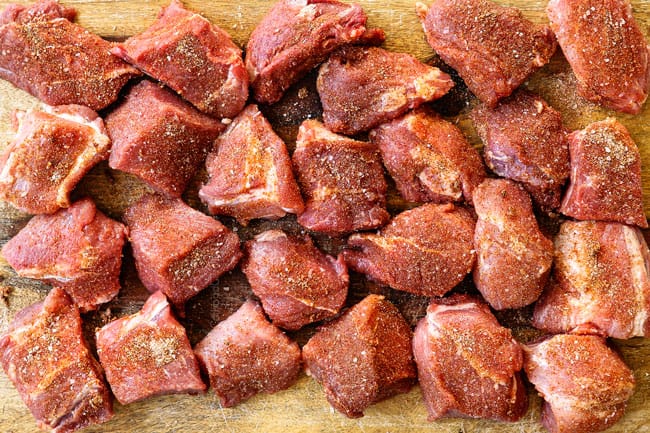
- Sear pork. Searing the pork creates complex flavors that can’t be achieved any other way through the Maillard reaction, also known as the flavor reaction. Searing the pork also seals in the spice rub and the juices which keeps your pork tender and juicy while cooking.
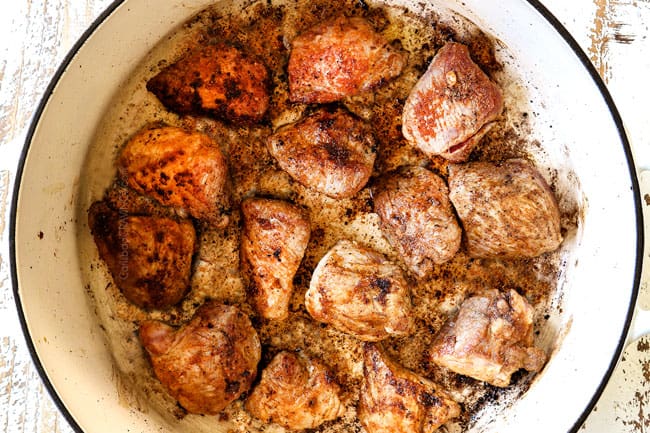
- Add stew ingredients. Once the pork is seared, you’ll sauté the onions in the same pot, scarping up those golden bits of flavor gold; then add the pork bone, chicken broth, diced tomatoes, green chilies, oregano, and bay leaves. The pork bone adds unparalleled flavor.
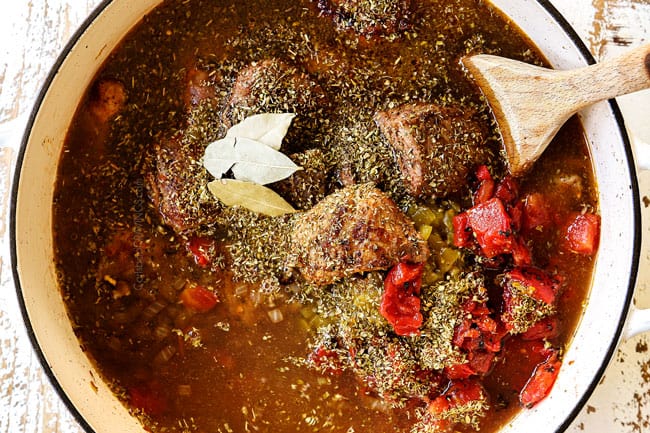
- Bake stew. Transfer the stew to the oven and bake until the pork is fall apart tender, about 90 minutes. If your pork doesn’t easily shred with two forks, it simply needs more time to tenderize – so pop it in the oven for another 30 minutes or so.
- Clean chili peppers. While the pork is cooking, we can multi-task and make the chili sauce and prep any garnishes. The chili sauce is made with dried chili peppers that will need to be cleaned and softened before blending into a sauce. It takes a few steps, but is relatively quick and easy. First, cut the tops off of all the chilies with kitchen shears. Next, cut the chilies along one edge to open them like a book to expose the seeds inside. Scrape out all of the seeds. The seeds contain most of the heat in the peppers – if you leave them in, your mouth will be on fire! Finally, close the chili peppers so they are ready to be toasted.
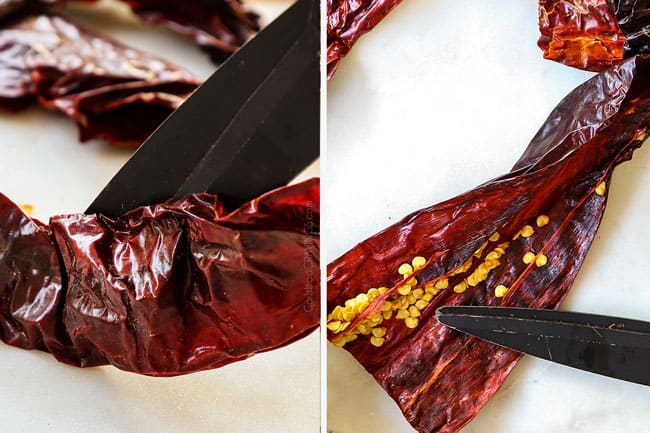
- Toast and soak chili peppers. We enhance the smokiness of the chili peppers by adding them to a hot skillet and toasting them until fragrant, just about 1 minute per side. Next, cover the chilies with water and simmer for 3-5 minutes until the chilies are softened. Most recipes have you pour hot water over the chiles and soak for 30 minutes but this shortcut method will have your chilies ready in minutes!
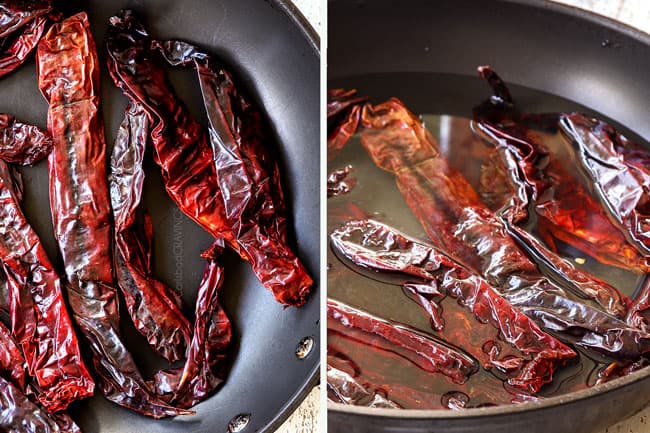
- Make chili sauce. Finally, we get to transform the beautiful, fragrant chilies into a sauce. Transfer the chilies along with 1 ½ cups of the skillet liquid to a blender. Add cocoa powder, sugar and cinnamon. These ingredients might sound odd, but they create the flavor of Mexican chocolate and add a subtle mole flair to the pozole soup. Process the peppers until smooth. If you don’t have a high-powered blender, then strain the chili sauce through a fine mesh strainer into a bowl, using rubber spatula to push the mixture through. If you do have a high-power blender- just double check that your sauce is smooth.
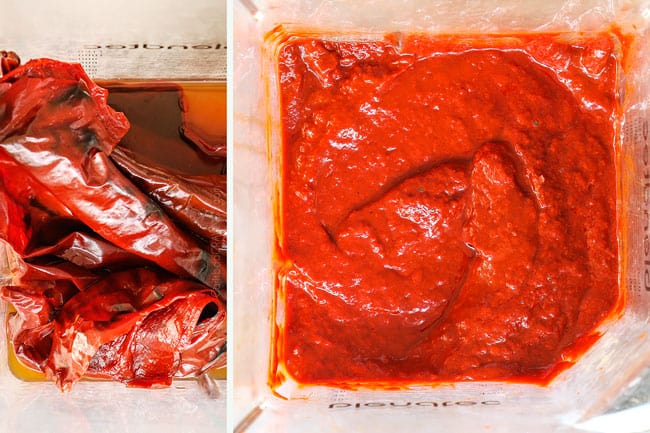
- Shred pork. Once your pork is fall apart tender, remove the pozole from the oven and transfer it to the stove. Using two forks, shred the pork into bite size pieces. I find the easiest way to do this is to transfer the pork pieces to a cutting board using a strainer, instead of fishing for them all throughout the pot.
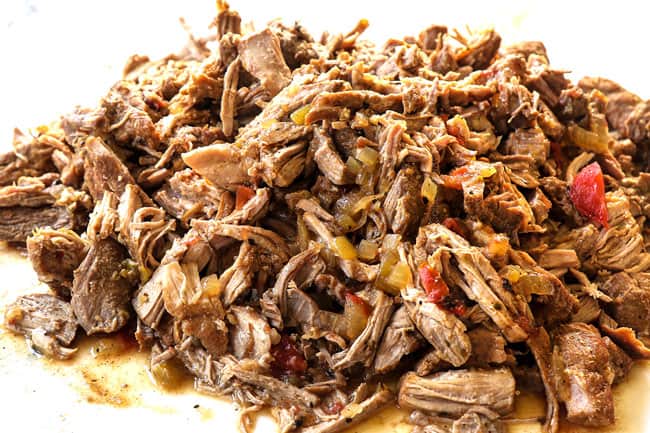
- Add remaining ingredients and simmer. Add the shredded pork back to the soup along with hominy, potatoes (if using) and chili sauce. Bring to a boil then reduce to a gentle simmer for 25 minutes, stirring occasionally.
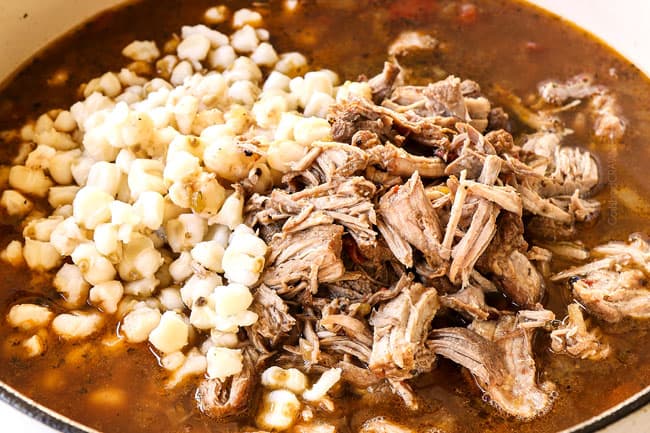
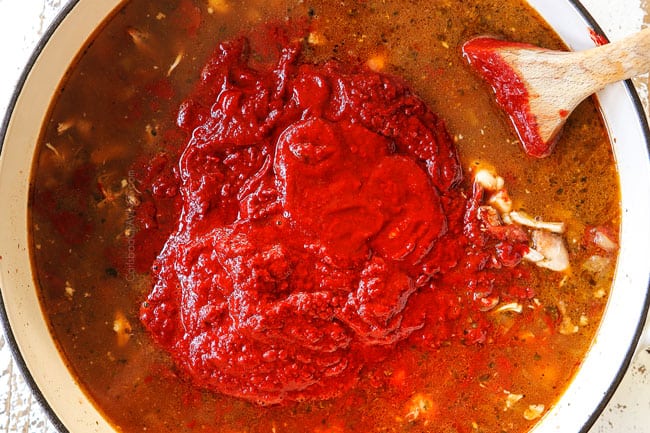
- Season to taste. After 25 minutes, season the soup to taste with additional salt. It will need more than you think, about 1 ½ -2 teaspoons salt, but start with less and add a little more at a time. This is also the time to add additional heat as well. You can add some of the reserved chili seeds or cayenne pepper to taste.
- Garnish; Now the fun! Let everyone top their soups with garnishes of choice.
How to Prep Pozole Recipe Ahead
This pozole recipe does require a few steps but the upside is you can prep different components ahead of time.
- Pork: can be trimmed and cut into chunks. You can even go one step further and season and sear the pork.
- Broth: if you sear the pork, add it to the soup pot along with all of the ingredients to the point where it’s ready to pop in the oven. When ready to bake, bring to a simmer before transferring to the oven.
- Shred pork: make the pozole up to the point of shredding the pork. Allow to cool before refrigerating. I like making the stew up to this point because the shredded pork soaks in the aromatic broth all night and in the morning, you can easily skim off the hardened fat. Now, all that’s left to do is add the hominy and chili sauce and simmer for 25 minutes.
- Chili sauce: can be made a few days ahead of time and refrigerated or frozen.
- Garnishes: can be prepped a day ahead of time and stored in separate airtight containers in the refrigerator.
Pozolo Rojo Recipe Tips
- Prep ahead. You can prep this soup in stages or even make it ahead completely for a stress-free dinner win. See the section below on how to prep ahead.
- Don’t burn pork or chiles. Take care you don’t sear the pork at too high of temperature and adjust the heat if needed. We want golden bits left behind in the pan and not black bits otherwise the pozole will taste burnt. Same goes for the chiles, toast them for just a minute or so – don’t let them burn!
- Bake until pork is tender. The tender, juicy shredded pork is the star of this pozole recipe, so don’t shortcut it. If your pork isn’t fall apart tender, cook on!
- Multitask. You can prep the chili sauce and the topping while the soup is in the oven so then you’re just a 25-minute simmer away once the soup comes out of the oven.
- Customize consistency. Pozole is a stew and as such, it is supposed to be on the chunky side. If you prefer it more brothy, simply add additional beef broth.
- Adjust to taste. If you feel like your finished pozole rojo is missing something, it is likely salt and heat. Once you season to taste with salt and either reserved chili seeds or cayenne pepper, then all the flavors will come alive.
- Don’t skimp the garnishes! The garnishes are especially important in Mexican pozole because the soup itself is rich and earthy. It needs the brightness and contrasting crunch the toppings provide.
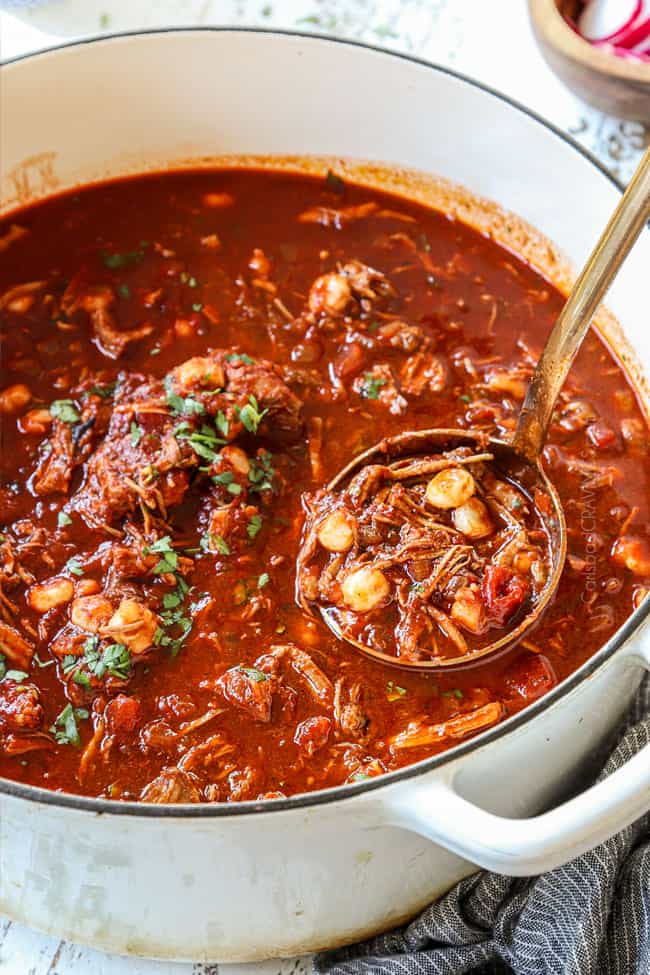
HOW DO I THICKEN pozole rojo?
Pozole rojo is meant to be a brothy soup. If you would like to thicken it up like chicken enchilada soup, then you can use masa harina (recommended) or cornstarch.
- Masa harina: whisk ¾ cup masa harina with 1 1 /2 cups of broth from the stew until smooth. Add to the pozole and bring to a simmer until thickened.
- Cornstarch: whisk 2 tablespoons cornstarch with ½ cup cold broth or water until smooth. Add to the soup at the end of cooking and bring to a simmer until thickened.
HOW DO YOU MAKE pozole CREAMY?
You can transform brothy pozole into creamy pozole using a few different methods:
- 1) add 4 oz. softened cream cheese at the end of cooking and stir until completely melted. This is the method I use in my Cheesy Taco Soup and Mexican Chicken Corn Chowder and it is fabulous.
- 2) add cream cheese and freshly grated cheese for added creaminess and enhanced flavor.
- 3) add part sour cream, part cream cheese OR part sour cream and part heavy cream at the end of cooking.
- 4) if you would like thick and creamy pozole, then whisk ¾ cup masa harina with 1 1 /2 cups of broth from the stew until smooth. Add to the pozole and bring to a simmer until thickened. Add 4 oz. softened cream cheese at the end of cooking and stir until completely melted followed by optional freshly grated cheese.
HOW DO I SPICE UP Mexican pozole soup?
Mexican pozole soup can be spiced up a number of ways: add reserved dried chili pepper seeds to taste, add cayenne pepper, minced chipotle chili peppers, minced canned jalapenos or hot sauce. Hot sauce is a nice option because you can line it up with the garnishes and let everyone customize their own spice level.
Pozole Recipe VARIATIONS
This pozole recipe is fabulous as written or feel free to make it all sorts of non-traditional by adding veggies, rice, cheese, etc.
- Add rice. Add 1 cup long grain white rice (I recommend basmati for the best texture) the last 10-12 minutes of cooking. You will need to add additional broth to accommodate the rice.
- Swap protein. You can make pozole with any protein! You can use chuck roast, chicken thighs, rotisserie chicken, ground beef or ground turkey.
- Add vegetables. Add any of your favorite veggies such as bell peppers, zucchini, chayote, sweet potatoes, butternut squash, etc.
- Add beans. Black beans or pinto beans would be a fabulous addition.
- Make it cheesy. Stir freshly shredded pepper Jack or Monterrey Jack cheese directly into the soup. This would be particularly tasty with the addition of 4 oz. softened cream cheese whisked into the soup.
HOW DO I MAKE Mexican Pozole IN THE CROCK POT?
This Mexican pozole recipe can be adapted to the slower cooker by first searing the pork and sauteing the onions on the stove then letting the crockpot do the rest of the work.
- Sear pork and sauté onions according to recipe directions.
- Spray a 6 quart (or larger) slow cooker with nonstick cooking spray.
- Add the pork, onions, garlic, cumin, chicken broth, diced tomatoes, green chilies, oregano, bay leaves, hominy and potatoes if using.
- Cook on HIGH for 6-7 hours or on LOW for 10-12 hours or until pork is very tender.
- Meanwhile, make the chili sauce according to recipe directions.
- Discard bay leaves and pork bone.
- Shred pork and add back to the crockpot along with the chili sauce. Cook on low for an additional 30 minutes. Season with salt to taste.
What to serve with pozole soup?
Pozole soup is traditionally served with warm corn tortillas or bolillos (savory Mexican bread) to soak up the rich broth. Sometimes tostadas or tortilla chips are used in place of fresh tortillas. Along with tortillas, tostadas or tortilla chips, every bowl is served with plenty of toppings. Toppings are a fun way to add crunchy and creamy textures and bright, fresh flavors to the stew.
Traditional toppings include sliced radishes, sliced cabbage, lime juice, cilantro, Mexican oregano, chopped arbol chiles, Cotjia cheese and diced onions/or thinly sliced red onions, but feel free to add whatever you like! Here’s the breakdown:
- Cabbage: a must for pozole! Thinly sliced cabbage adds a fresh, contrasting crunch.
- Radishes: add a delightful spicy, peppery, zesty crunch.
- Onions: you can use thinly sliced red onions (my preference) or chopped white onions.
- Lime juice: awakens the flavors of the entire soup and cuts through the richness.
- Cilantro: chopped cilantro adds a fresh, zesty flair.
- Avocado: chopped or sliced avocados add a wonderful creaminess.
- Cotija cheese: is Mexican cheese made from cow’s milk that’s salty and crumbly, similar to Parmesan.
- Mexican crema or sour cream: is not a traditional topping but it adds a wonderful creaminess and its refreshing tanginess compliments the robust, rich flavors. You can also use fat free sour cream or Greek yogurt.
At any point while your pozole rojo is in the oven or simmering, you can prep the toppings and store in the refrigerator. When ready to serve, create a toppings bar and let everyone dress their own pozole.
HOW many days is Mexican pozole good for?
Mexican pozole tastes even better the next day! It will last up to 5 days in an airtight container in the refrigerator or 3 months in the freezer.
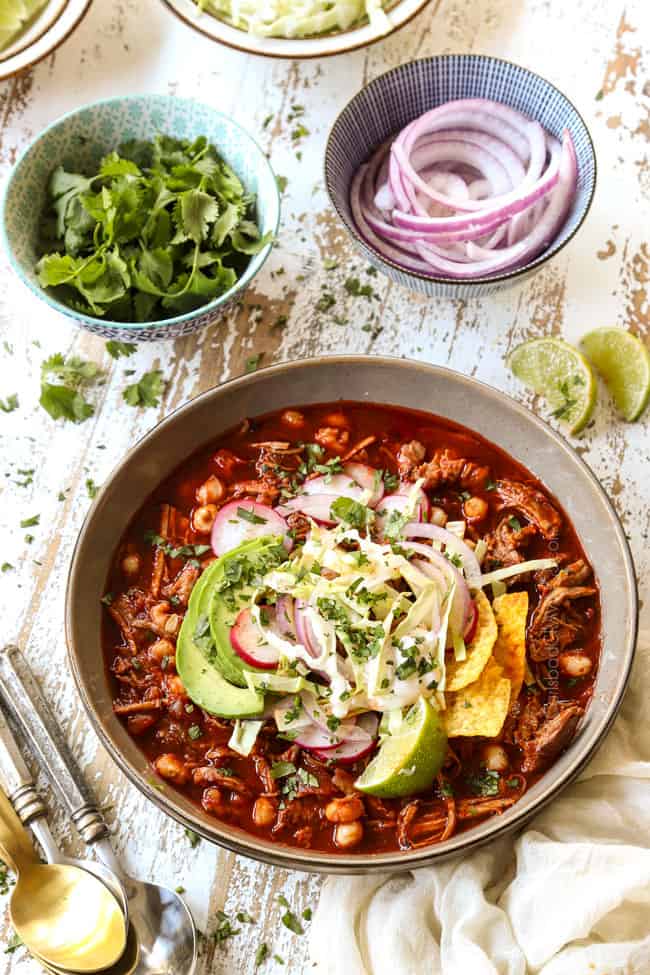
How to FREEZE pozole soup
Pozole soup freezes and reheats beautifully because it doesn’t contain any dairy or vegetables that can become mushy. Here’s how:
- Cool. Cool pozole completely before freezing.
- Package soup in a freezer safe container. You can use sandwich size plastic bags for individual soup portions, quart size bags or freezer bags. To easy fill these bags, place them in a container that you can wrap the top around the edge of – for example, place a sandwich size bag in a mug then cuff the edges around the mug. This keeps the bag open and prevents it from collapsing when you are pouring in your pozole. Final packaging tip, make sure to let out any excess air before you seal.
- Label. Make sure to label your bags so it doesn’t’ become a freezer mystery. You also want to label so you can be sure to use your soup within 3 months.
- Freeze. Once cooled and labeled you are ready to freeze your soup. Once the bag is solid you can lay it flat in a single layer so it’s stackable to save space.
- Thaw/Reheat. The easiest way to thaw your soup is in your refrigerator overnight then reheat on the stovetop or in the microwave. If you forget to thaw your soup beforehand or are hit with a need-pozole-now craving then you can thaw the soup in the microwave. Transfer frozen soup into a microwave-safe container, partially cover and microwave for 2-3 increments, until the soup has become slushy, stirring in between so it thaws evenly.
HOW DO I REHEAT POZOLE soup?
You can reheat pozole soup on the stove, in the microwave or crockpot:
- Stove: reheat large batches on the stove over medium low heat, stirring occasionally – about 10 minutes.
- Microwave: transfer individual servings to a microwave-safe dish, cover with a microwave-safe lids or paper towel. Microwave for 2 minutes, stir, then continue to microwave for 30-second intervals, if needed.
- Crockpot: transfer soup to a crockpot and heat on low for 1-3 hours. The time will depend on how much soup you have remaining.
Red Pozole Recipe FAQs
Yes! If you stick to the ingredients in this recipe, then your pozole soup will be gluten free.
Pozole soup made with guajillo chili peppers or guajillo peppers and ancho peppers is not spicy, just flavorful. The heat comes from the arbol chili peppers. They are 15 to 30 times spicier than ancho chiles and 6 to 12 times spicier than guajillo chiles. If you don’t want a spicy soup, then omit the arbol chili peppers altogether, otherwise add 1-3 peppers depending on how spicy you would like it. You can also add cayenne pepper to taste after the soup is done, so it is better to error on less arbol chiles than too many.
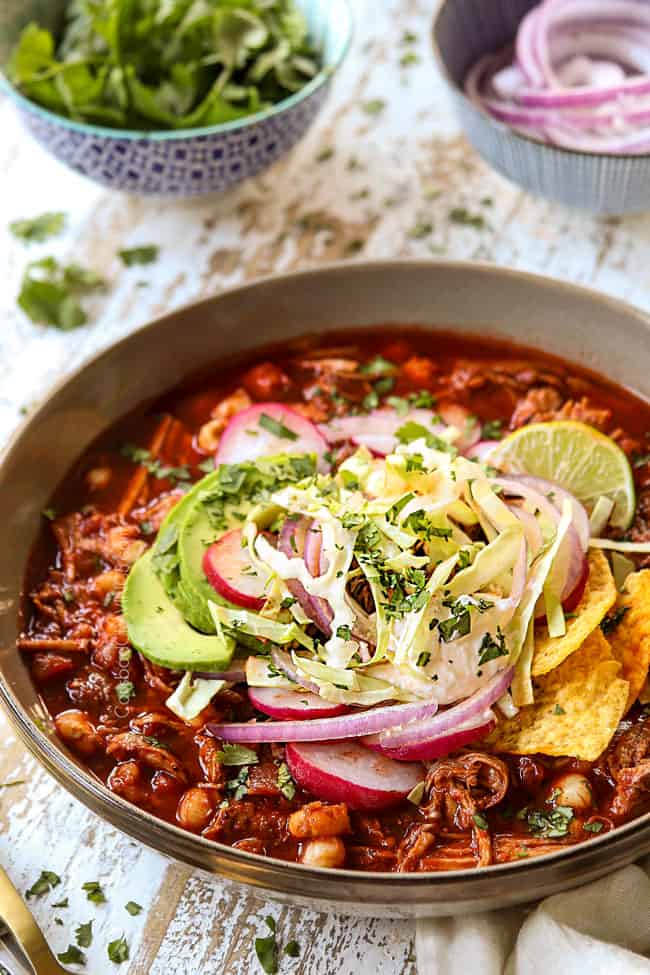
Want to try this Pozole RECIPE?
Pin it to your Soup, Mexican or Dinner Board to SAVE for later!
Find me on Pinterest for more great recipes! I am always pinning :)!
©Carlsbad Cravings by CarlsbadCravings.com
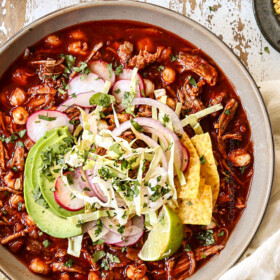
Pozole Rojo Recipe
Save This Recipe To Your Recipe Box
You can now create an account on our site and save your favorite recipes all in one place!
Ingredients
PORK
- 4-5 pounds pork butt, bone-in if available trimmed of excess fat and cut into 4-inch pieces
- 1 tablespoon kosher salt
- 1 1/2 tsp EACH ground cumin, garlic powder, onion powder, smoked paprika
- 1/2 teaspoon pepper
STEW
- 2 tablespoons vegetable oil
- 1 large onion chopped
- 4 garlic cloves minced
- 1 tablespoon ground cumin
- 7 cups low sodium chicken broth
- 1 14 oz. can fire roasted diced tomatoes with juices
- 1 4 oz. can mild chopped green chilies
- 1 tablespoon dried oregano preferably Mexican
- 1 teaspoon ground coriander
- 3 bay leaves
- 3 15 oz. cans white or yellow hominy drained and rinsed
- 2 1/2 cups Yukon gold potatoes peeled, chopped 1/2-inch (optional – see notes)*
- salt and cayenne pepper to taste
CHILI SAUCE
- 4 ounces dried guajillo peppers or guajillo + ancho peppers
- 1-3 arbol chile peppers optional if you like heat
- 2 teaspoons unsweetened cocoa powder
- 2 teaspoons sugar
- 1/4 teaspoon cinnamon
GARNISHES (pick your favs!)
- warmed corn tortillas, tostadas or tortilla chips
- thinly sliced cabbage
- thinly sliced radishes
- thinly sliced red onion
- chopped cilantro
- chopped avocados
- fresh lime juice
- Cotija cheese
Instructions
STEW
- Preheat oven to 300 degrees F.
- Whisk the pork seasonings together. While the pork is still on the cutting board, pat the pieces dry then rub pork all over with the seasonings, set aside. Reserve the bone.
- Heat the vegetable oil in a large, (7-9 quart) Dutch oven over medium-high heat. Add the pork and brown on all side; remove to a plate. Add the onions and cook until softened, scraping up the brown bits, about 5 minutes. Add the garlic and ground cumin and sauté 30 seconds.
- Add the pork back to the pot followed by the pork bone, chicken broth, diced tomatoes, green chilies, oregano, coriander and bay leaves. Cover to bring to a boil then transfer to the oven. Bake at 300 degrees F until the pork is fall apart tender, about 90 minutes.
CHILI SAUCE
- While the pork is cooking, make the chili sauce. Cut the tops off of all the chilies with kitchen shears. Cut chilies along one edge to open like a book; scrape out all of the seeds. Reserve some of the seeds to finish the soup if you want more heat.
- Heat a large skillet over medium-high heat. Add chiles and briefly toast until fragrant, about 1 minute on each side. Cover the chilies with enough water so that they aren't touching the bottom of the skillet (careful it will steam a lot). Simmer for 3-5 minutes until chilies are softened.
- Remove chilies to blender along 1 ½ cups of the skillet liquid, cocoa powder, sugar and cinnamon. Process until smooth, leaving a corner of the blender open so steam can escape; set aside. If you don’t have a high powered blender, then strain the chili sauce through a fine mesh strainer into a bowl, using rubber spatula to push the mixture through.
FINISH SOUP
- Remove the pot from the oven and transfer to the stove. Discard bone. Using two forks, shred the pork (I find it easiest to transfer pork to a cutting board using a strainer, shred, then add back to pot). Add the hominy and chili sauce to the pot. Bring to a boil then reduce to a gentle simmer for 25 minutes, stirring occasionally. Season with 1½ -2 teaspoons salt and either some reserved chili seeds or cayenne pepper to taste for a spicier soup.
- Garnish individual bowls with garnishes of choice.
Notes
Tips and Tricks
- Step by step instructions: see post for detailed step by step photos and instructions.
- *Potatoes: are not authentic to pozole but I think they add SO MUCH fabulous texture and flavor (every stew needs potatoes!). If you add the potatoes, reduce the hominy to two 15 oz. cans.
- Dried Chiles: you can use all guajillo peppers or a combination of guajillo peppers and ancho peppers. Both of these peppers are not spicy so the resulting chili sauce will be mild with a slight sweetness. If you would like a spicy soup, then add 1-3 arbol chili peppers OR you can season the soup with cayenne pepper to taste at the end of cooking.
- Pork butt/shoulder: both pork butt and pork shoulder come from the front of the pig (not the rear). If you have a choice between pork butt and pork shoulder, use pork butt, often called Boston butt because it has more fat marbling throughout the meat so it emerges more fall-apart-tender.
- Hominy: is what this recipe is named after and should not be skipped! Use canned hominy located near the corn at your grocery store.
- Don’t burn pork or chiles: take care you don’t sear the pork at too high of temperature and adjust the heat if needed. We want golden bits left behind in the pan and not black bits otherwise the pozole will taste burnt. Same goes for the chiles, toast them for just a minute or so – don’t let them burn!
- Bake until pork is tender: the tender, juicy shredded pork is the star of this pozole recipe, so don’t shortcut it. If your pork isn’t fall apart tender, cook on
- Customize consistency: pozole is a stew and as such, it is supposed to be on the chunky side. If you prefer it more brothy, simply add additional beef broth.
- Don’t skimp the garnishes! The garnishes are especially important in Mexican pozole because the soup itself is rich and earthy. It needs the brightness and contrasting crunch the toppings provide.
- Storage: store pozole in an airtight container in the refrigerator for up to 5 days or freeze for up to 3 months.
- Make Ahead: You can make the entire pozole ahead of time because it reheats beautifully. Alternatively, you can prep the recipe through step 4, except go one step further and shred the pork. Allow to cool to room temperature then refrigerate 1-2 days. When ready to finish the soup, skim off the hardened fat, add the hominy and chili sauce and simmer for 25 minutes.

Did You Make This Recipe?
Tag @CarlsbadCravings and Use #CarlsbadCravngs
Leave a Review, I Always Love Hearing From You!
Carlsbad Cravings© Original
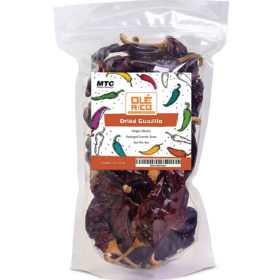

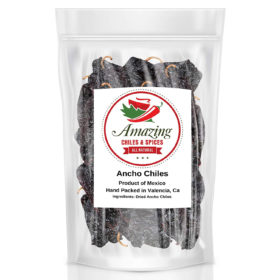
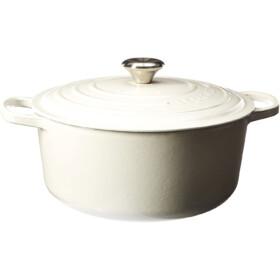







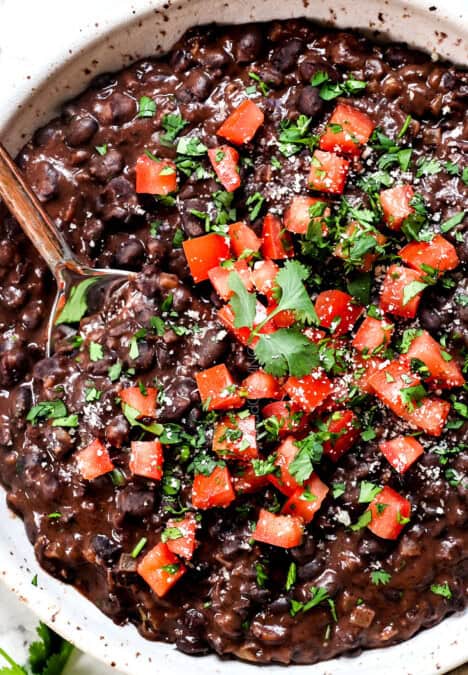

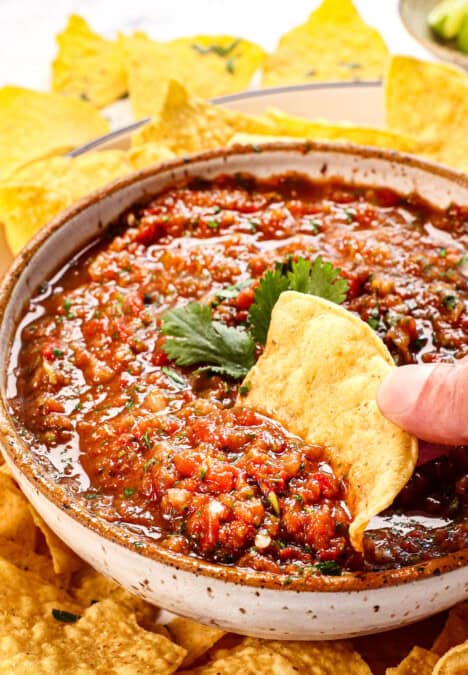
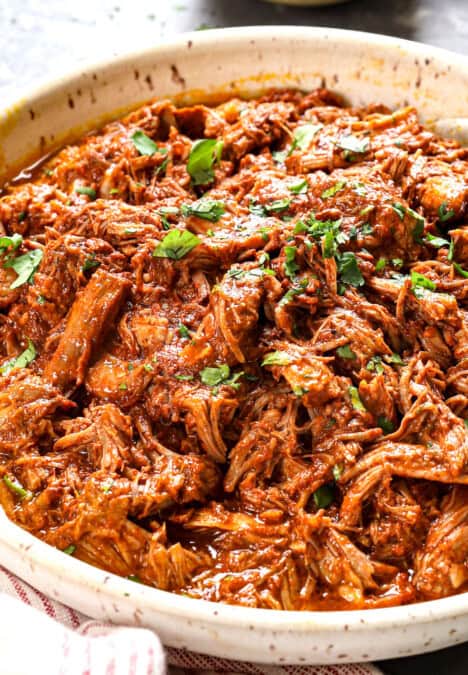
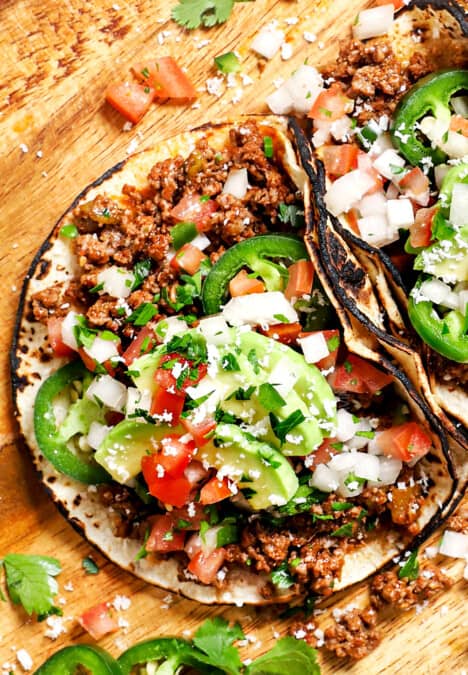


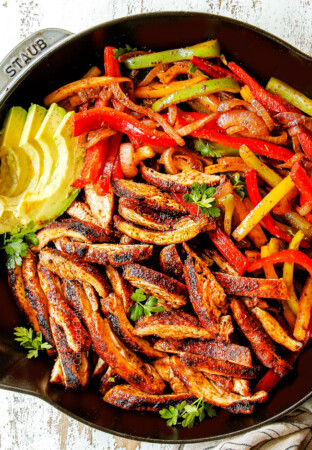
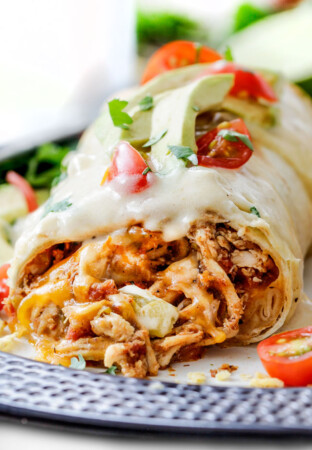
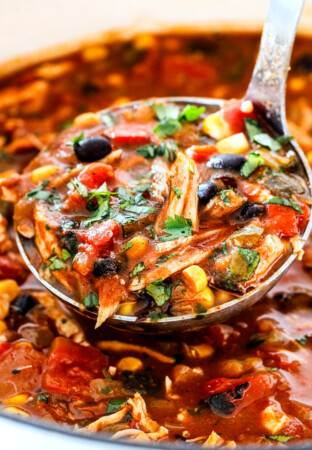





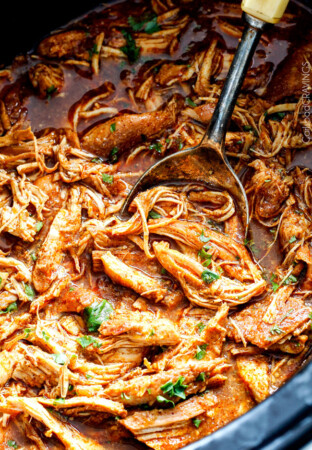




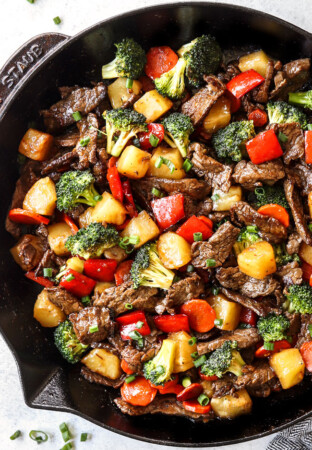

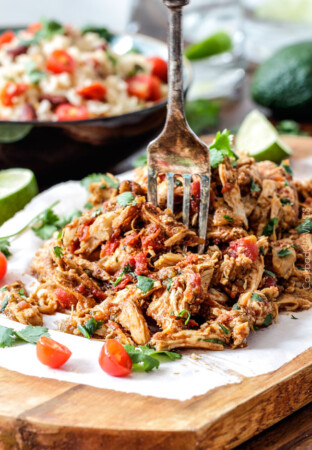
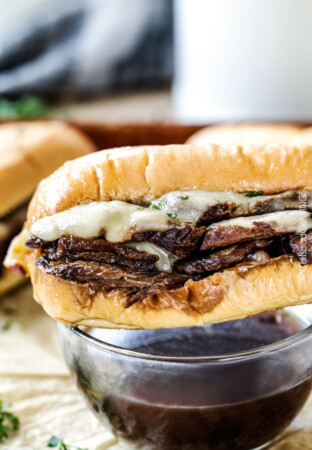
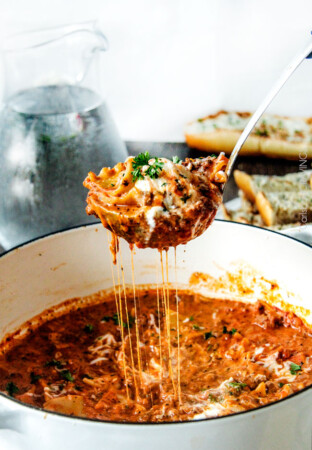

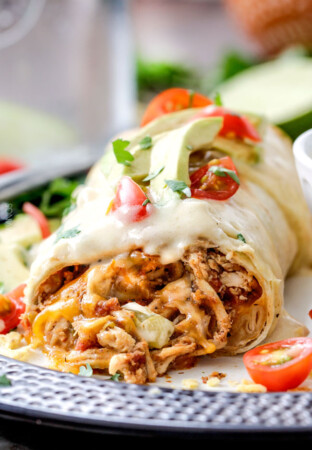

Stephanie says
I am SOOO excited to see this recipe & can’t wait to make it this week. I spent a couple years living in New Mexico and it truly was the best culinary experience in my lifetime. New Mexican’s love their Pozole and their recipes are so diverse going either the green chili or red chili route, some are brothy, some are more stew like. I can see your recipe will be incredible, I have the dried chilis already just need some hominy. YAY!
Jen says
I’m excited you’re excited Stephanie! That is so great you were able to live in New Mexico and experience so many of their wonderful, diverse foods and recipes! I hope this pozole reminds you of your New Mexico days!
Jennifer Fulk says
This recipe looks delicious! I make pozole a few times a year and can’t wait to try your recipe. I always use trocitos de puerco ( pork stew meat) because it’s from the leg . For some reason I do not like shoulder pork meat or any pork meat from the front. Do you think I could substitute the pork stew meat in your recipe with success? I realize I won’t have a bone though. I was just thinking the other day..I wonder if Jen has a pozole recipe. It’s starting to cool off a bit here in Cali , so I immediately start thinking about making soups- my favorite food. 🙂
Jen says
Thanks Jennifer, that’s awesome you’re already a pozole connoisseur! Yes, I think it will definitely still work with the trocitos de puerco and be fabulous. I’m excited for you to try this version and look forward to hearing what you think!
Stephanie says
Jen I made your pozole yesterday which was perfect for a snowy, lazy, park on the couch after church, Sunday football kind of day. It was incredible. While I liked the pozole I had tried over the few years I lived in New Mexico, nothing compares to this recipe you create or the depth of flavor you magically created here. I did not use the arbor chilies or potatoes. You have a real gift for getting the spices and seasonings just right, especially in your Mexican recipes. You turn ordinary dishes into extraordinary ones and my family along with 2 kids who used to be picky eaters now have adventurous palates when your meals grace our table. Thank you!
Jen says
Thank you, thank you Stephanie for being the first to review this pozole recipe! I am thrilled to hear this recipe is the best you’ve tried, that means so much to me! I’m honored your family continues to enjoy my recipes! xo
michelle says
This dish was a labor of love and so worth the effort. It was delicious and so flavorful. Do not skip the toppings it takes this dish to the next level. I added the chili sauce to the pot with everything and let it cook through instead of adding at the end. Will definitely make this again, even for company!
Jen says
Thanks so much Michelle, I’m so pleased it will be a repeat!
Tom says
I am interested in trying this recipe because of the pot in the oven technique alone. But what happens to the usual scum and foam that floats up when you simmer it on the stove top? I usually skim that off, but it looks like this would not present an opportunity to do so.
Jen says
Hi Tom, there isn’t a ton of extra fat but you can skim it off the top once you pull it out of the oven. Good luck!
Amanda says
This is amazing! It might seem complicated to make but everything is super easy. Just a little time consuming. Well worth the effort and will be a staple in my house along with the polzole verde.
Jen says
Thanks so much for taking the time to comment Amanda and for the high praise! I’m so pleased to hear this recipe will be on repeat!
Claire says
I found this to be really salty. I used chicken broth and beef better than bouillon. I would use regular salt not kosher salt next time.
Jen says
Hi Claire, Better Than Bouillon is quite salty, so if you omitted that it would probably be perfect.
Fred Kelley says
Hey Jen. Love pozole, and this one did not disappoint. In my recipe I usually use, I never add cocoa powder or sugar or cinnamon, so I was a little leary. So glad I did because it adds depth of flavor to the chile sauce. Adding all the toppings is a must, adds so much to the dish. Cold and rainy here for a few days, so this will help, for sure. Thank you.
Jen says
Thanks for taking the time to comment Fred, I’m so pleased you enjoyed this recipe so much! And I’m glad you enjoyed the cocoa powder, etc., I add it to my enchilada sauce too!
Stephanie says
Do you think I can make this with chicken instead of pork?
Jen says
Yes! Just adjust the cooking time as needed.
Brenda says
Wow this is yummy , never had hominy before so when I saw this recipe I thought why not try it. Used two small Arbol peppers and it gave it just enough kick for me . Time consuming but I love making soup for the week and meal prep Sundays .
Jen says
I’m so pleased you gave it a try! Thank you for taking the time to leave a review!
S Brooks says
Born & raised in New Mexico, so I have ate ALOT of mexican food! I had not had the cinnamon/cocoa/sugar flavor before. I will definitely leave it out the next time I make this! A very different flavor for me!?! The meat turned out very tender & flavorful. I plan to use that part of the recipe for future tacos/burritos. This recipe does take ALOT of time, so be prepared to be in the kitchen for hours!
Jen says
Thank you for your comment! I love the flavor of the popular Mexican dish Mole which is a cocoa, cinnamon, and sugar sauce that is often used on chicken. I’m glad you loved the meat!